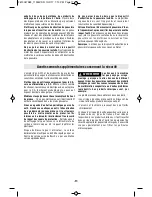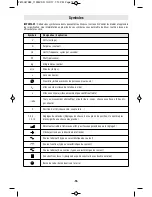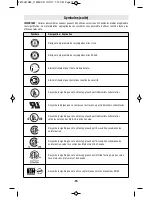
Always use the side handle for maximum
control over torque reaction or kick-back.
Never attempt to operate this tool with
one hand.
The slip clutch engages if you
firmly control the tool during a torque reaction
or kickback.
Always wear safety goggles or eye
protection when using this tool. Use a
dust mask or respirator for applications
that generate dust.
Safety goggles or eye
protection will help deflect fragments of the
material that may be thrown toward your face
and eyes. Dust generated or gases released
from the material you are cutting (i.e.
asbestos insulated pipes, radon) may cause
respiratory difficulties.
Use thick cushioned gloves and limit the
exposure time by taking frequent rest
periods.
Vibration caused by hammer-drill
action may be harmful to your hands and
arms.
Position the cord clear of rotating bit. Do
not wrap the cord around your arm or
wrist.
If cord becomes entangled with the
spinning bit it could entrap you causing
serious personal injury.
Position yourself to avoid being caught
between the tool or side handle and walls
or posts.
Should the bit become bound or
jammed in the work, the reaction torque of
the tool could crush your hand or leg.
If the bit becomes bound in the
workpiece,
release
the
trigger
immediately, reverse the direction of
rotation and slowly squeeze the trigger to
back out the bit.
Be ready for a strong
reaction torque. The tool body will tend to
twist in the opposite direction as the bit is
rotating. (Note: use only if tool has reversing
feature.)
Do not strike the bit with a handheld
hammer
or
sledgehammer
when
attempting to dislodge a bound or
jammed bit.
Fragments of metal from the bit
could dislodge and strike you or bystanders.
Never place the tool down until the bit or
accessory has come to a complete stop.
Do not use dull or damaged bits and
accessories.
Dull or damaged bits have a
greater tendency to bind in the workpiece.
When removing the bit from the tool avoid
contact with skin and use proper
protective gloves when grasping the bit or
accessory.
Accessories may be hot after
prolonged use.
Do not run the tool while carrying it at
your side.
A spinning bit could become
entangled with clothing and injury may result.
If devices are provided for the connection to
dust collection and extraction systems, be
sure these are connected and used
according to tool and vacuum instructions.
Proper use of dust collection can reduce dust
related hazards.
If devices are provided for the connection of
dust collection and extraction systems,
empty the dust container before beginning
work, frequently during work, after
completion of work, and before storing the
tool.
Be extremely careful of dust disposal,
materials in fine particles form may be
explosive.
Do not throw dust on an open fire.
Combustion from mixture of varnishes,
lacquers, polyurethane, oil or water with dust
particles can occur if there is a static discharge,
electric spark, or excessive heat.
Do not use dust extraction for operations
where dust may include burning, smoking
or smoldering items like hot ashes or
sparks.
Fire inside the vacuum tank or bag
may occur. Dust may smolder and set vacuum
on fire long after work is completed.
Do not use dust extraction with explosive
dusts, varnish, polyurethane coatings,
cleaners, or oil-based paints.
Electric motors
create sparks which may ignite the dust or
fumes.
Do not use dust extraction when working on
metal.
Swarf from drilling metal may be hot and
may spark which may melt plastic adaptors,
vacuum hoses and may cause a fire inside the
vacuum tank or bag.
Do not drill into metal with the dust
extraction system mounted.
Hot metal chips
can self-ignite or ignite parts of the dust
extraction system.
Do not drill into wood with dust extraction
system mounted.
Wood chips are typically too
large and will clog the dust channel.
Your tool is equipped with a dust canister,
empty it frequently, after completion of
drilling and before storing the tool.
Be
extremely careful of dust disposal, materials
in fine particle form may be explosive.
Note:
Do not use the dust extraction system
when chiselling, screwdriving or cutting threads.
-4-
2610047983_11253VSR 10/2/17 1:10 PM Page 4

























